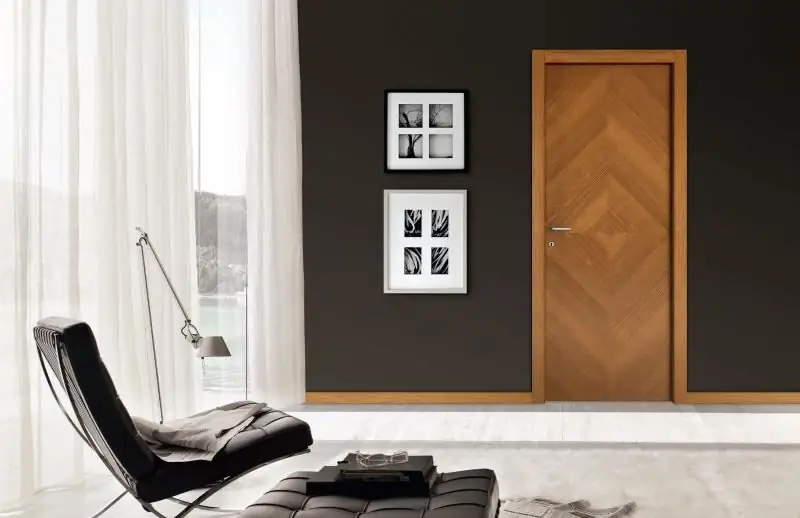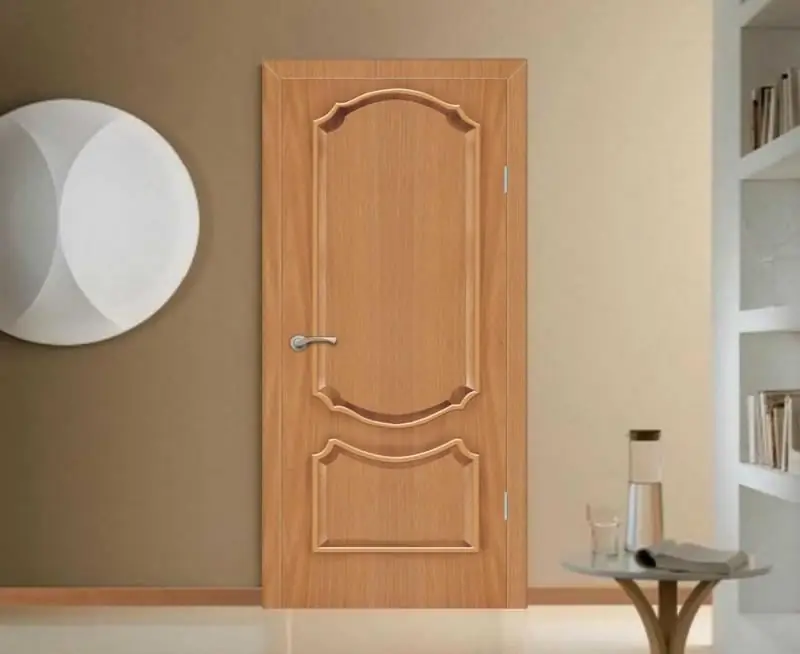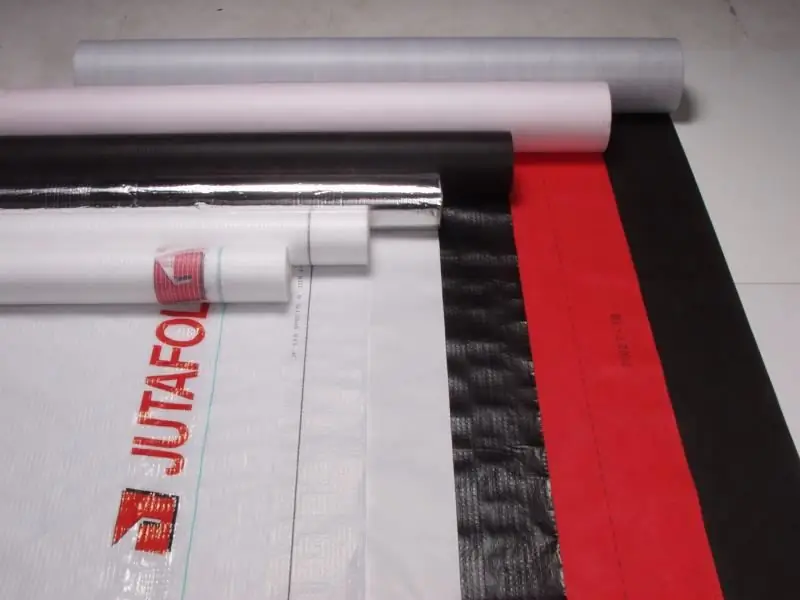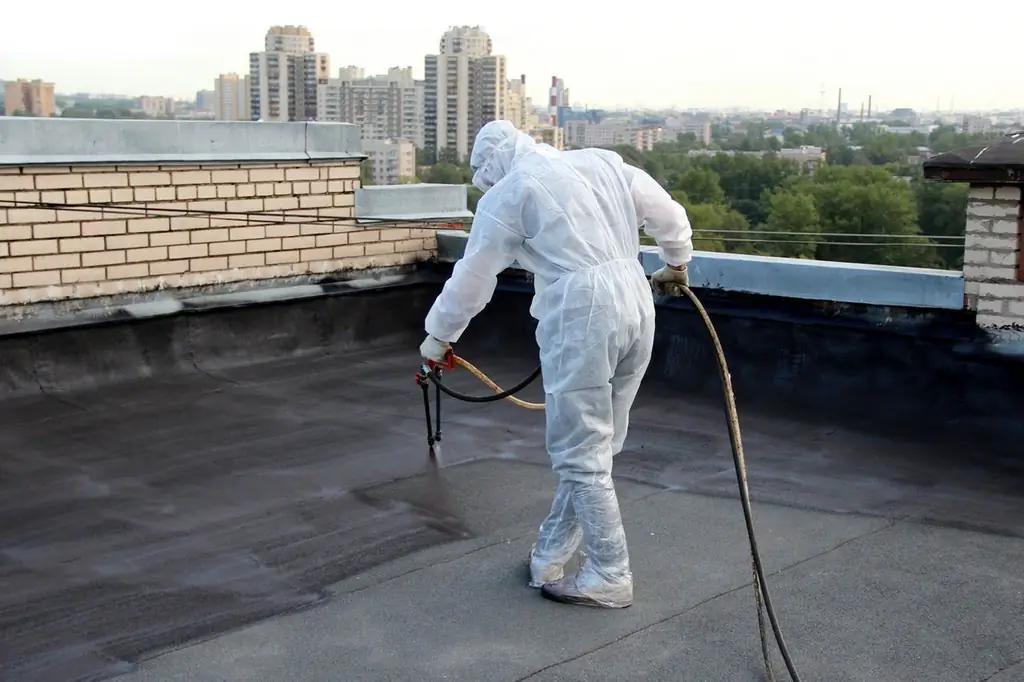
Table of contents:
- Author Bailey Albertson [email protected].
- Public 2023-12-17 12:53.
- Last modified 2025-01-23 12:41.
Do-it-yourself door soundproofing

In order to protect your house from street noise or an apartment from extraneous sounds at the entrance, you need to install soundproofing doors. Soundproofed doors can also be used to ensure the maximum level of indoor comfort. Such designs will be especially relevant for rooms in which silence is a prerequisite: bedroom, study, children's room, office, meeting room, hotel, etc.
Content
-
1 Factors of sound transmission
1.1 Video: Checking the quality of a soundproof door
-
2 Classification of soundproof doors
2.1 Features of choice
-
3 Varieties of soundproofing material
3.1 Video: Checking the performance of sound insulation materials
-
4 How to make soundproofing doors with your own hands
- 4.1 Sound insulation of the door with disassembly of the leaf
- 4.2 Upholstery with noise insulation around the outer perimeter
- 4.3 Video: Do-it-yourself door soundproofing
Sound conductivity factors
Sound insulation of housing is achieved by increasing the sound insulation characteristics of walls, windows, ceilings, floors and doors. If you decide to install soundproof doors in a house or apartment, then their effectiveness will be minimal, if you do not perform general protection of the room from extraneous noise.
After completing a comprehensive soundproofing of the house, you can protect yourself from extraneous noise and ensure a comfortable stay in all rooms. Children will sleep well, you will be able to work in the office without being distracted by extraneous sounds, or you will listen to music loudly without disturbing other household members or neighbors.

Installation of soundproof doors is one of the stages of a set of measures to improve the acoustic environment in a house or apartment.
The main elements that transmit sound vibrations are:
- Material. Plastic, metal, wood or glass can be used to make the door. Glass and plastic doors have the least sound insulation characteristics. The best barrier to acoustic waves is created by wooden or pressed wood canvases.
- Design. The canvas can be solid, hollow, with filler or inserts. Hollow doors and products with glass or plastic inserts work the worst. Solid wooden doors and canvases with filling provide maximum protection from extraneous noise.
- Door type. Folding and swinging structures provide the minimum level of sound insulation. Sliding doors have somewhat better performance. Swing models provide maximum noise insulation.
Soundproofing and soundproofing doors have different purposes. To ensure silence in the room and protect it from extraneous noise, soundproof modifications must be installed. They are used in bedrooms, offices, children's rooms. If it is necessary that the noise does not leave the room, it is equipped with a noise-insulating door. This is done, for example, in playrooms and music rooms.
Video: checking the quality of a soundproof door
Classification of soundproof doors
In principle, any doors are soundproof, as they protect the room from extraneous sounds, they just do it differently. Conventional doors can reduce noise levels by 26-30 dB. If you want to increase this value, you need to install models of special design.
There are two types of noise from which it is necessary to protect the interior:
- air - transmitted in the form of sound waves;
- structural - occurs as a result of mechanical influences, for example, the movement of furniture or the operation of a power tool;
-
percussion - issued during certain sharp manipulations, for example, strikes, jumps, etc.

Types of noise There are three types of noise, each of which is generated and transmitted in a different way
There are state standards that determine the standards for sound insulation of all types of noise. Depending on the class of the house, certain standards have been developed for each category of sound.
House classes:
- A - enhanced comfort (business and elite class);
- B - normal comfort (comfort class);
-
В - acceptable conditions (economy class).

House classes According to the quality of living conditions, all houses are divided into classes, each of which has its own requirements for all characteristics of comfort, including sound insulation
In appearance, all doors are practically the same. The whole difference in terms of sound insulation lies in their internal structure. To characterize the protective qualities of doors against noise, there is the term "sound insulating ability".
For airborne noise, the required sound insulation capacity of the door depends on the class of the house:
- A - 54 dB;
- B - 52 dB;
- B - 50 dB.
For impact noise, the indicators will be as follows:
- A - 60 dB;
- B - 58 dB;
- B - 55 dB.
Constant noise or too loud a sound creates discomfort and can irritate the human nervous system. A calm reaction will be to the noise level in the range of 25-60 dB. Long-term exposure of a person to sound with a force of up to 90 dB leads to the development of insomnia, nervous disorders or neuroses. Sounds exceeding 100 dB can cause hearing loss.
To ensure good sound insulation of the room, it is necessary to install doors with a maximum level of sound insulation:
- first. They can protect against noise up to 32 dB. For comparison, it is worth pointing out that a sound wave of 45 dB is created during a conversation;
- increased. Such models are ways to protect against noise of 40 or more dB, it all depends on the materials used.
The highest quality doors are made on the principle of a sandwich panel. They consist of several layers of soundproofing materials. Outside, such doors are sheathed with leatherette, MDF or similar coatings.
Selection features
Taking into account the fact that an ordinary door delays about 26-30 dB, with an external sound of 60 dB, 30-34 dB enter the apartment. If this is not enough, you can purchase doors with increased noise insulation or soundproof standard structures yourself. A noise level of 25-50 dB is considered comfortable for a person.
For specialized premises (recording studios, game rooms) or in special cases when it is necessary to provide a high level of sound insulation, for example, in a bedroom or a children's room, it is necessary to purchase ready-made soundproof doors. Entrance fire doors have good performance in terms of acoustic protection. They are capable of resisting noise up to 45 dB.
It is not necessary for all doors to be soundproofed. It is enough to install them only in those rooms where it really should be quiet. For such purposes, wooden canvases, fiberboard doors are suitable, but not hollow.
If you decide to install glass doors, then in order to ensure normal sound insulation characteristics, you must use structures with one- or two-chamber double-glazed windows
Varieties of soundproofing material
The following can be used as a filler to create soundproof doors:
-
sintepon is a soft fibrous material. To ensure high sound insulation characteristics, it must be laid in several layers;

Sintepon For good sound insulation, the synthetic winterizer must be laid in several layers
-
corrugated cardboard. It looks like a honeycomb. It is used in cheap doors, as it has not very high soundproofing characteristics;

Corrugated cardboard Corrugated cardboard is used in cheap doors
-
polystyrene. It can be produced in sheets or granules, as well as in a liquid state;

Polystyrene Polystyrene is available in sheets, granules or in liquid state
-
mineral wool. This material has good sound insulation and fire protection characteristics. Its disadvantage is that, being in the doorway, it gradually shrinks, so after a while the protective characteristics deteriorate. In addition, mineral wool absorbs water, so it cannot be used on the doors of rooms with high humidity and on entrance lobbies;

Mineral wool Mineral wool shrinks, so it must be well fixed
-
foam rubber is a cheap and affordable material that is used for external soundproofing of a door;

Foam rubber Foam rubber is used for sound insulation over the door leaf
-
splen - so called acoustic foam rubber. It absorbs sound vibrations well, and is attached to the door surface due to the adhesive layer;

Splen Splen is a type of foam rubber and has a self-adhesive base
-
izolon - another type of foam rubber with higher soundproofing characteristics;

Izolon Izolon has higher sound insulation characteristics than standard foam rubber
-
Styrofoam. It has good noise insulation performance, but it has low fire safety, therefore it is rarely used in the construction of doors;

Styrofoam Polyfoam has low fire safety, so it is practically not used for soundproofing doors
-
foamed polyurethane - allows for good soundproofing of doors and has a high resistance to fire;

Foamed polyurethane Foamed polyurethane has a high resistance to fire
-
vibration filter. It is a multi-layer material consisting of aluminum foil and bitumen. It adheres well to the door surface and provides good sound insulation.

Vibration filter Vibration filter consists of aluminum foil and bitumen
In addition to the use of fillers, it is possible to perform soundproofing of the door using a panel that is attached from above to the main leaf. To do this, use lining, laminate, MDF, fiberboard, leatherette. It will help to increase noise insulation and the presence of an air gap between the main and additional canvas.
There are a few more simple ways to increase the noise insulation of the door:
-
automatic threshold. It is a magnetic strip that is installed in the floor. When the door is closed, the gasket is attracted to the metal strip fixed to the bottom of the door leaf and ensures a tight closing;

Automatic threshold Automatic threshold allows additional soundproofing of doors
- door frame seal. With the help of polyurethane foam or mortar, all the gaps between the door frame and the opening are sealed and thus the noise level coming from the outside is reduced;
-
use of seals. Seals are installed along the perimeter of the door, which improves the tightness and sound insulation. Can be used:
- magnetic;
- silicone;
- rubber;
- foam rubber - yellow;
-
Isolone seals - they are white and have a higher density compared to foam rubber.

Types of seals Seals can be made from different materials
All seals sold in the store usually have an adhesive backing. Silicone products are fixed with a plastic rib.
Video: checking the performance of sound insulation materials
How to make soundproofing doors with your own hands
Before proceeding with the independent soundproofing of doors, you need to prepare all the necessary tools and materials:
- electric drill and set of drills;
- saw;
- scissors;
- knife;
- a hammer;
- screwdrivers;
- construction hair dryer;
- soundproof material;
- upholstery;
- fasteners;
-
glue.

Door soundproofing tools Depending on the type of insulation chosen and the method of soundproofing the door, the set of tools may vary slightly
Depending on the chosen insulation and the method of soundproofing the door, the set of tools may vary slightly
Soundproofing can be carried out with or without disassembling the door.
Sound insulation of a door with leaf disassembly
Consider the process of performing work with disassembling the door leaf:
-
Preparatory work. At this stage, it is necessary to remove all objects from the door leaf that will interfere with the work: peephole, handles, number plate, etc. In order to make it easier to work, you can remove the door leaf, but if it is difficult, then sound insulation can be done without it …

Preparatory work Before performing sound insulation, the hardware is removed from the door so that it does not interfere with work
-
Removing the upholstery. Inexpensive wooden doors are usually covered with leatherette on top. To remove it, you need to pull out the fasteners. After that, remove a sheet of fiberboard or hardboard. Most metal doors are sold already insulated and have a non-separable structure. If it is possible to remove the sheathing sheet from the metal door, then it is also removed.

Removing the upholstery The upholstery and, if possible, the facing sheet are removed from the door
-
Laying soundproofing. If you use materials with an adhesive base, the inner surface of the door must be wiped well and degreased with acetone. After that, the filler is glued - usually these are bituminous vibration isolators, such as "Visomat", "Bimast", and light anti-noise coatings "Splen" or "Vibroplast". First, heavy materials are glued to the door surface, for example "Visomat", and "Splen" is laid on it with overlapping seams. The process is similar to gluing wallpaper, and in order for the material to fix well, the work must be done at a temperature of +20 o C or more. In cold weather, it is recommended to warm up the door surface with a construction hairdryer.

Laying soundproofing material Soundproofing material is fixed with glue or on a self-adhesive base
-
Thermal insulation. This is an optional step, but if the door has already been disassembled, then after installing the sound insulation, a layer of mineral wool can be laid. After it has been laid, a fishing net or fabric struts are nailed on top, which will hold the insulation plates.

Laying mineral wool Mineral wool is placed between the stiffening ribs, additionally fixing it with a mesh or other materials at hand
-
Installation of wiring. If an electric lock is installed in the door, then wires are laid to it.

Installation of wiring On the inner surface of the door, wires are laid to connect the electric lock
-
Seam processing. In addition to soundproofing the door leaf, it is necessary to properly seal the seams between the door frame and the door leaf. For this, modern seals are used that do not spoil the appearance of the door and ensure its tight closing.

Installation of seals The sealing element is fixed on the frame along the line of its contact with the canvas
-
Soundproofing the threshold. Special sound-absorbing thresholds for interior doors can be purchased in the store. On the entrance doors, the soundproofing of the threshold is achieved by installing a bottom seal.

Soundproofing threshold To ensure sound insulation of the threshold, a lower seal is installed
Soundproofing around the outer perimeter
If it is impossible to disassemble the canvas, its soundproofing is carried out from above. Soft padding can be used for this, but panels are more popular. They are sold ready-made, so you only need to attach them to the canvas.
Any home craftsman can do such work, since the panels are fixed with glue or self-tapping screws. In addition to improving the soundproofing characteristics, installing soundproofing panels improves the appearance of the door.
Overhead soundproofing panels can be from:
- MDF or fiberboard;
- laminate;
- lining;
-
dermantine.

Overhead soundproof panels Overhead soundproofing panels can be made from different materials, but most often they are made from MDF
A wooden frame can also be fixed along the perimeter of the door, sound-insulating material can be placed in the resulting space and sewn up with a patch panel. This solution will allow you to get a better result than installing only one panel.
Video: do-it-yourself door soundproofing
Extraneous noise reduces the level of comfort, so it will be uncomfortable to stay in such a room. Installing soundproof entrance doors will help get rid of external noise coming from the street or from the entrance. Interior soundproof doors will help isolate a separate room. This will allow children to sleep normally, and adults to work quietly in the office or listen to music, without disturbing neighbors or other people in the apartment.
Recommended:
MDF Doors: Entrance And Interior Doors, Their Varieties With A Description And Characteristics, Advantages And Disadvantages, As Well As Installation And Operation Features

Doors from MDF: features, characteristics, varieties. Making and installing MDF doors with your own hands. Door restoration. Reviews, photos, videos
Polycarbonate For The Roof And Its Types With A Description, Characteristics And Features Of Installation And Operation

Polycarbonate and its types. How to choose polycarbonate for your roof. Features of storage and installation, service life. Consumer reviews
Roof Vapor Barrier And Its Types With Description And Characteristics, Features Of Materials And Installation

Roof vapor barrier, its types, description and characteristics. Features of materials for roof vapor barrier. Installation methods for each of the materials
Thermal Insulation Of The Roof And Its Types With A Description And Characteristics, As Well As Features Of Materials And Installation

Description of the types of roof insulation, as well as the main materials for insulation and their properties. How to properly install thermal insulation on the roof and how to work
Roof Waterproofing And Its Types, As Well As Features Of Its Design And Installation, Depending On The Roofing Material

What materials can be used to arrange reliable waterproofing of the roof and how to install it
